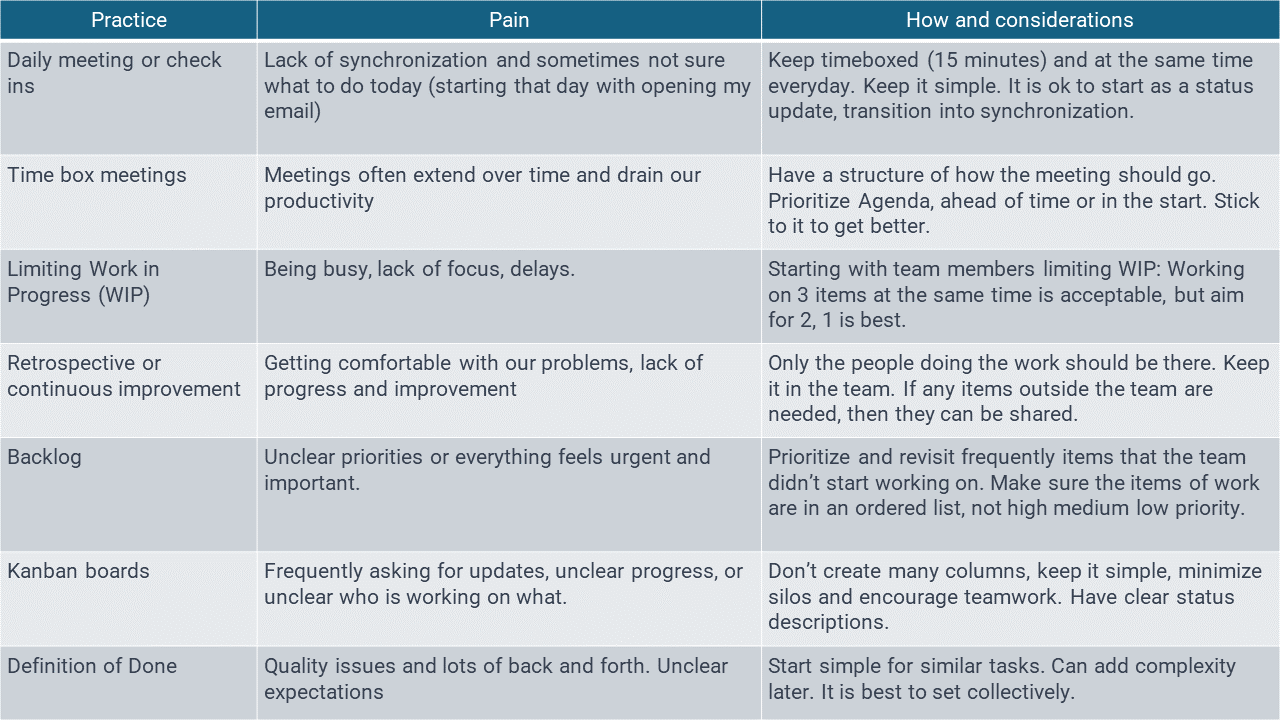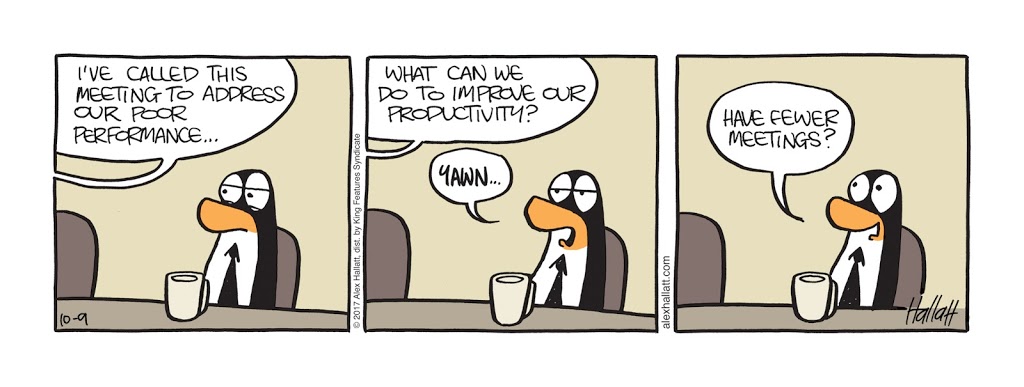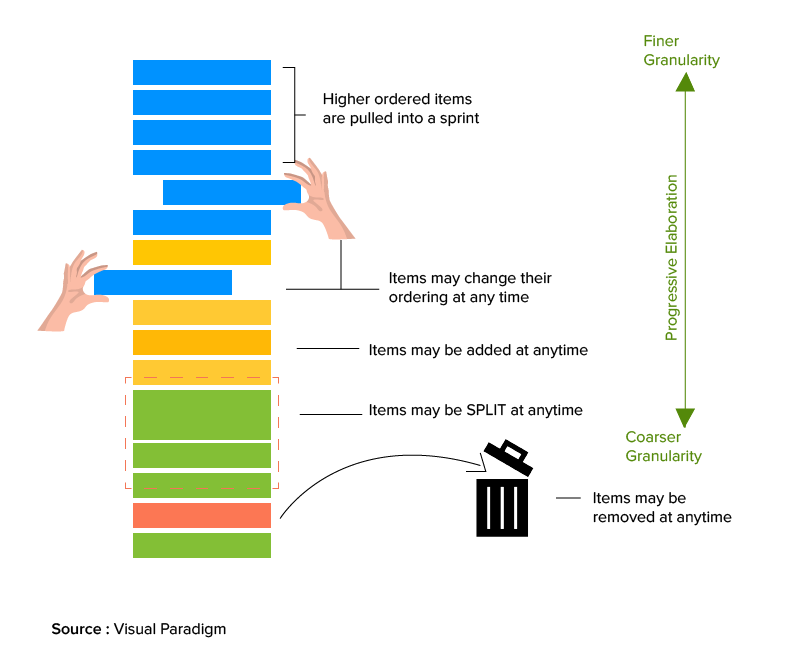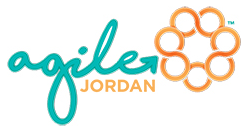7 Universal Agile practices
Here are 7 Agile practices that adds value for all teams and all situations!! Don’t start all at the same time, one at a time:
- Daily meetings or check-ins
- Time-box meetings
- Limit work in progress (WIP)
- Retrospectives or continuous improvement
- Backlog
- Kanban boards
- Definition of Done

Universal Agile practices for any team. Number 1: Daily meeting or check-ins
The concept is to see progress on a daily basis and do fast adjustments and plan for the day. It creates opportunities for team members to collaborate, support each other, and make sure no work is duplicated.
Having a status update where the manager is listening to “The 3 boring questions” will not get the full benefit. However, practically it can be a good start as people are familiar. Over time managers should listen only and then not even attend if they have no work and attend if the team wants them.
Do’s and Don’ts of the daily standup:
- Do identify problems and blockers, do not do problem solving.
- Do listen to everyone, Don’t have one person hijack the meeting.
- Do finish early if it makes sense, don’t go over the time box.
- Do have it at the same time, don’t keep switching it or delaying the start.
Check the scrum guide (even if you are not doing scrum)
Universal Agile practices for any team. Number 2: Timebox meetings
Meetings, meetings, and more meetings. At least let us control the meeting time.
Timeboxing concept is simple:
1st: Prioritize so that when the time ends, you finish more important things first
2nd: Always, always, finish on time.
3rd: If you finish earlier, finish. You do not HAVE to take over the entire meeting time.
A good place to start practicing this concept is in the daily meeting. This allows you to see how often you finish all needed to discuss on time, and then how much time did you start shaving off it.
Overall, this will improve your meeting skills.
Having a time keep who makes sure we are abiding by time is crucial, pick someone who has the discipline to keep the team on track.

For general meetings recommendations: Check this article
Scary meetings statistics:
- Average delay per meeting for employees is 10 minutes and 40 seconds, equivalent to 3 days and 2 hours lost annually.
- The salary cost of an hour-long meeting with 5 attendees (from specialist to director level) is $338 USD.
- Want more: Check out this link.
Universal Agile practices for any team. Number 3: Limiting Work in Progress (WIP)
Let us be real, multitasking is a myth.
Maybe I will give some context, as humans we can automate tasks, such as driving to work. We are so familiar with that activity that it becomes automatic to level that sometimes you get lost in thought and you are surprised you arrived. However, remember when you started learning to drive, your brain was all in.
Our knowledge work is mostly like learning to drive every day.
Limiting work in progress can be easily implemented on an individual level. You cannot have more than parallel tasks opened at the same time, you either finish, cancel, return or defer. Start on the individual level, do not go over 3 tasks as a limit, ok to have 2, and it is best to have one as it is the actual representation.
Later on you can take this concept to the entire team (or parts of the team) where they can have one task they are working on together. This pushes collaboration to a new level.
There is a huge difference in productivity when people are focused, and that is the purpose of limiting the WIP. Keep your team focused.
Finally, and maybe counter intuitively, limiting WIP greatly improves the flow of work, how? Because it pushes those issues to the surface, it allows us to identify them in the process of work, which then we can work on solving.
Universal Agile practices for any team. Number 4: Retrospective or continuous improvement
Reality is that change is gradual, there are feelings and epiphanies of change. However, change and improvement is a process. Having systematic time to revisit how things are done and improve it is what enables that improvement to become sustainable.
In the scrum guide there is a good brief I will use:
“(The team discusses) what went well during the Sprint, what problems it encountered, and how those problems were (or were not) solved.
(The Team) identifies the most helpful changes to improve its effectiveness. The most impactful improvements are addressed as soon as possible. They may even be added to the Sprint Backlog for the next Sprint.“
You do not have to apply scrum, consider it just a simple recurring meeting every once in a while to discuss continuous improvements.
Major don’ts:
- Do not turn into a blame game, focus on what to improve and how to avoid problems in the future.
- Expose the meeting for outside the team. Do not include managers.
- Leave without actionable items.
A great list I found for more dos’s and don’ts can be found here.
Universal Agile practices for any team. Number 5: Backlogs
What are backlogs? Ordered items of all the work that needs to get done. There is one key word “Ordered.” And that means the top item on that list is more important than the second, third and all items afterwards.
This makes prioritization disciplined. It allows no space for discussion of what is more important. If you ask anyone in the team, what is the most important item they can simply point to the top of the backlog.
The backlog also helps create a space to discuss priority collectively as it is now visualized. And creates clarity of what needs to be done to achieve goals.
Finally, the backlog can be continuously revisited, refined, and discussed. So do not think of it as a fixed item.

Universal Agile practices for any team. Number 6: Kanban boards
Kanban boards have been used in all areas and even started in manufacturing.
The most important principle in any Kanban board is clear status definition. That means what does each step in the process mean, when can it go to the next step, is there a limit to the work in the step (Limiting work in progress).
This allows the team as a whole (and even authorized stakeholders) to know the current status of work. No need to interrupt the team to ask about what is the current status of a certain task as it is transparent on that board. Issues can be quickly identified, flow metrics measured, and the process improved.
Avoid turning the process steps into silos and keep it simple. Here is a guide to creating your kanban board.
Universal Agile practices for any team. Number 7: Definition of Done
The simplest and most elusive of practices.
This is the quality standard especially at the end of all the work done. I heard terms throughout my career when people are asked how the progress on this task or that project and I hear it is something like 96% done. This is unneeded complexity and even misleading, the last 4% take more time than the first 96%. Definition of Done looks at things as black and white. 99.9% done is NOT DONE.
The definition of done is shared among types of work for the team. Example: Research tasks have a definition of done while painting tasks have a different definition of done.
Initiate the DoD as a conversation with the team. And continue to improve the quality standard and clarity of DoD over time.
Here are some examples and tips to get you started.
